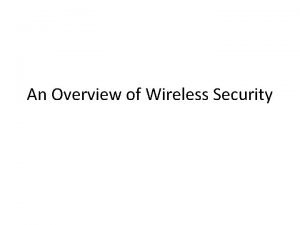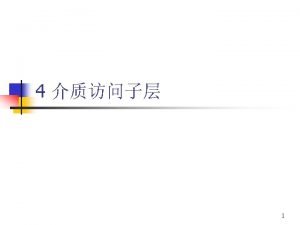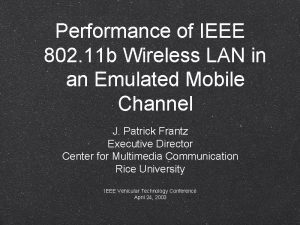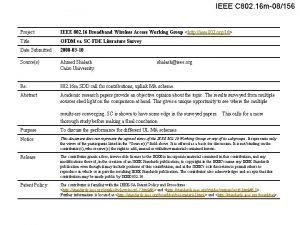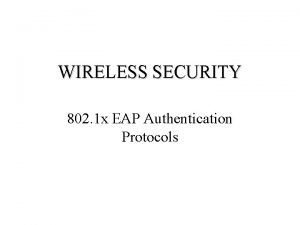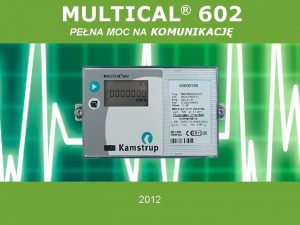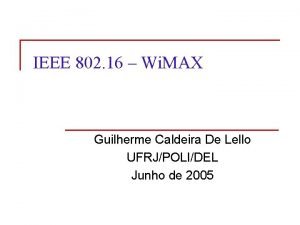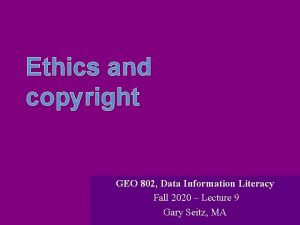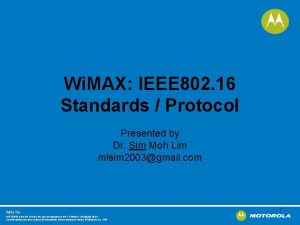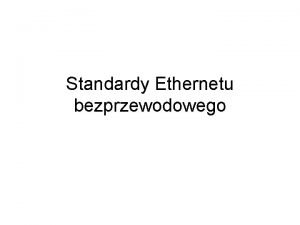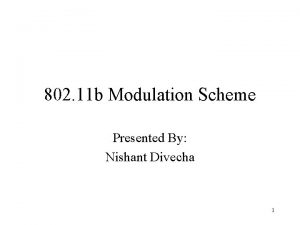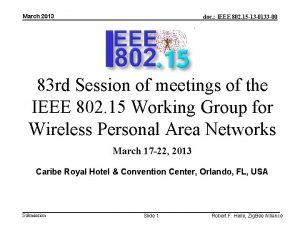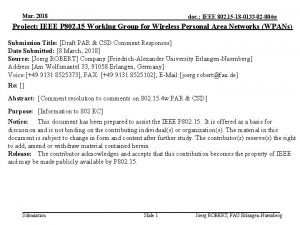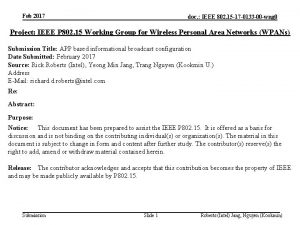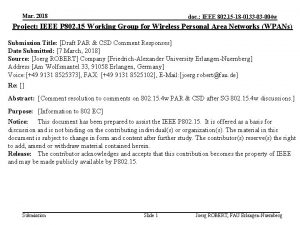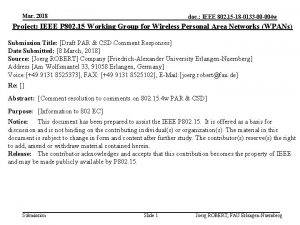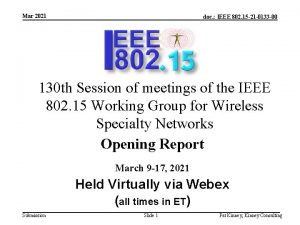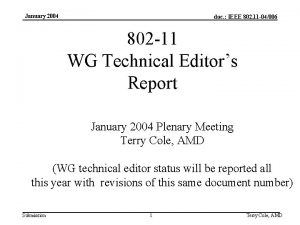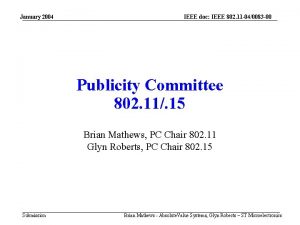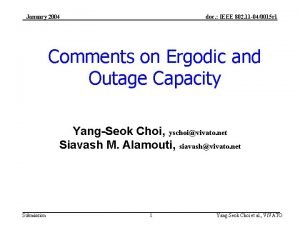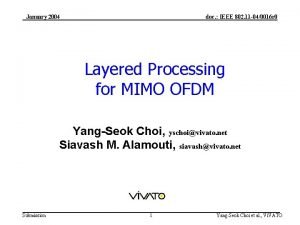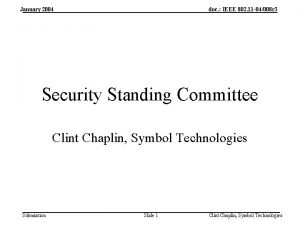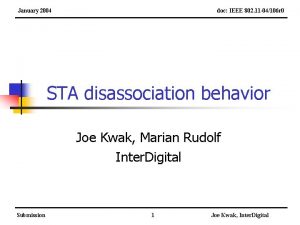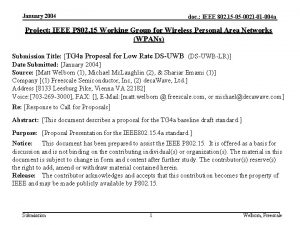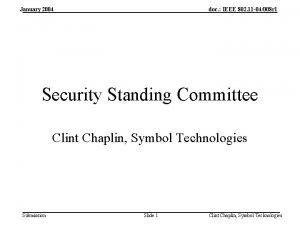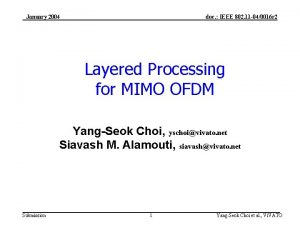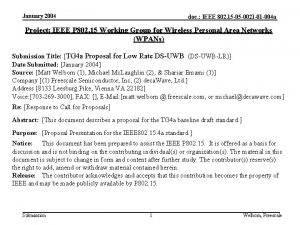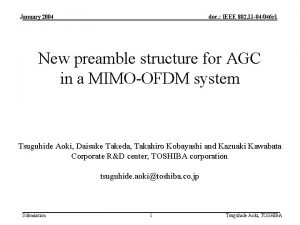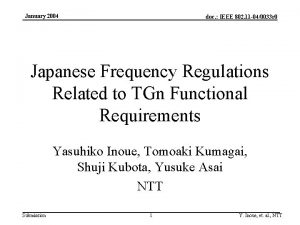January 2004 doc IEEE 802 11 04 0133






















- Slides: 22

January 2004 doc. : IEEE 802. 11 -04 -0133 -01 -000 e Chapter 11 Comment Resolution for Letter Ballot 63 Steve Emeott, Floyd Simpson, Stephen Wang Motorola Mark Bilstad Cisco Submission 1 Steve Emeott et. al Motorola,

January 2004 doc. : IEEE 802. 11 -04 -0133 -01 -000 e Addresses Ballot Comments • APSD power management – – – – Submission Comment 8 Comment 17 Comment 18 Comment 20 Comment 21 Comment 23 Comment 149 2 Steve Emeott et. al Motorola,

January 2004 doc. : IEEE 802. 11 -04 -0133 -01 -000 e Notations • In this document, text in red is added. Text in blue in parentheses is deleted Submission 3 Steve Emeott et. al Motorola,

January 2004 doc. : IEEE 802. 11 -04 -0133 -01 -000 e Trigger Issue (Comment 21) The text stating “If the non-AP QSTA has set up unscheduled SPs, the QAP shall buffer frames until it has received a frame from the non-AP QSTA, which indicates the start of an unscheduled SP” permits the QAP to initiate an unscheduled SP after receiving any frame from the non-AP QSTA, which can lead to wasted bandwidth if an unscheduled SP is not required. Submission 4 Steve Emeott et. al Motorola,

January 2004 doc. : IEEE 802. 11 -04 -0133 -01 -000 e Trigger; 11. 2. 1. 4 Motion: Modify text in sub-clause 11. 2. 1. 4 as follows • APSD defines two different types of delivery mechanism, depending upon the SP used. An SP can be either unscheduled or scheduled. An unscheduled SP begins when the QAP receives any “trigger” frame, which is a Qo. S-Data or Qo. S-Null frame associated with an admitted uplink or bidirectional TSPEC having its APSD subfield set to 1 and the schedule subfield set to 0 from the non-AP QSTA. Submission 5 Steve Emeott et. al Motorola,

January 2004 doc. : IEEE 802. 11 -04 -0133 -01 -000 e EOSP Issue (Comment 149) The power-save mechanism introduced through the submittal of document 11 -03 -0661 -00000 e is technically flawed, and does not really accomplish the stated goals. There exist technical issues with the mechanism that have not been resolved, specifically the ordering of varying priority frames and their use of the "more data" and EOSP indications. For example, if a QSTA has requested unscheduled APSD service periods, and the QAP buffers traffic for this device, the frames buffered may have more than one priority. Assume that 2 of the frames are "high" priority, and were the first two frames received, and a third frame is best effort traffic, and was the last frame received. The QAP, upon receiving an uplink frame from the QSTA will take the buffered frames and place them in the appropriate "priority" queues. At the time that it enqueues the frames the QAP will likely set the appropriate indicates (more data & EOSP). If the last frame enqueued is the best effort frame, and it has the EOSP bit set, but there is a substantial amount of high priority traffic enqueued at the QAP and little if any best effort traffic other than this frame, then there is a probability that the QAP will send the best effort frame BEFORE the high priority frames that indicate "more data". This would prematurely terminate the service period, allowing the QSTA to go back to sleep immediately, missing traffic, and resulting in inefficient channel utilization due to retries, timeouts, etc. Submission 6 Steve Emeott et. al Motorola,

January 2004 doc. : IEEE 802. 11 -04 -0133 -01 -000 e EOSP; 11. 2. 1. 4 Motion: Modify text in sub-clause 11. 2. 1. 4 as shown below: • An unscheduled SP begins when the QAP receives any frame from the non-AP QSTA (and ends after the QAP has attempted to transmit all frames destined for the non-AP QSTA). An unscheduled SP ends when the non-AP QSTA receives a frame from the QAP associated with a TSPEC using unscheduled delivery with the EOSP bit set to 1. In cases where the non-AP QSTA has transmitted trigger frames associated with multiple admitted TSPECs, the SP ends when the non-AP QSTA receives frames from the QAP associated with each of the TSPECs using unscheduled delivery with the EOSP bit set to 1. Submission 7 Steve Emeott et. al Motorola,

January 2004 doc. : IEEE 802. 11 -04 -0133 -01 -000 e EOSP; 11. 2. 1. 5 g Motion: Modify text in sub-clause 11. 2. 1. 5 g shown below: For all frames except for the final frame of the SP, the EOSP subfield of the Qo. S Control field of the Qo. S data frame shall be set to 0 to indicate the continuation of the SP. If necessary the QAP may generate an extra Qo. S Null frame, with the more data subfield set to 0 and the EOSP set to 1. (When the QAP has transmitted a directed frame to the non-AP QSTA the EOSP subfield set to 1 during the SP, it shall not transmit any more frames using this mechanism until the next SP). The QAP shall use EOSP=1 to indicate the end of SP in APSD. Submission 8 Steve Emeott et. al Motorola,

January 2004 doc. : IEEE 802. 11 -04 -0133 -01 -000 e Deliver All Issue (Comment 18) The text stating “The QAP shall transmit all frames buffered for the non-AP QSTA following a scheduled SP”, is problematic because the delivery of unadmitted traffic to a STA in PS mode leaves no means for the non-AP QSTA to pause or stop delivery of the unadmitted traffic, and because the QSTA does not enjoy the benefits of the used time function available to an AC with admitted streams. Submission 9 Steve Emeott et. al Motorola,

January 2004 doc. : IEEE 802. 11 -04 -0133 -01 -000 e Deliver All; 11. 2. 1. 4 Motion: Incorporate the changes outlined in 04/133 r 2 slides 10, 11, and 12: A non-AP QSTA may signal its desire to utilize APSD as the power-save mode delivery method for individual traffic streams by setting the APSD subfield of the TS info field contained in the TSPEC element to 1. (When a QSTA sets the APSD subfield for any TSPEC to 1, all traffic to the station shall be delivered using APSD). Submission 10 Steve Emeott et. al Motorola,

January 2004 doc. : IEEE 802. 11 -04 -0133 -01 -000 e Deliver All; 11. 2. 1. 5 (c) Motion (continued): Modify text in sub-clause 11. 2. 1. 5 c as follows, and (continued on next slide): • If a non-AP QSTA set up a scheduled SP, then the QSTA automatically (transitions to active mode) wakes up at each SP. Therefore, the QAP shall transmit (all) frames associated with admitted traffic with APSD subfield set to 1 in the TSPECs buffered for the non-AP QSTA following a scheduled SP. If the non-AP QSTA has set up unscheduled SPs, the QAP shall buffer frames until it has received a trigger frame from the non-AP QSTA, which indicates the start of an unscheduled SP. The QAP transmits frames destined for the non-AP QSTA associated with an admitted TSPEC having the APSD subfield set to 1 and the schedule bit set to 0 during an unscheduled SP. Submission 11 Steve Emeott et. al Motorola,

January 2004 doc. : IEEE 802. 11 -04 -0133 -01 -000 e Deliver All; 11. 2. 1. 5 (g) Motion (continued): Modify text in sub-clause 11. 2. 1. 5 g as follows • At each scheduled APSD SP for a non-AP QSTA, the QAP shall attempt to transmit (all) frames associated with admitted TSPECs with the APSD subfield set to 1 that are destined for the non-AP QSTA. At each unscheduled SP for a non-AP QSTA, the QAP shall transmit frames associated with admitted TSPECS with the APSD subfield set to 1 and the schedule bit set to 0 that are destined for the non-AP QSTA. Submission 12 Steve Emeott et. al Motorola,

January 2004 doc. : IEEE 802. 11 -04 -0133 -01 -000 e TIM & MD Issue (Comment 20) The normative behavior of the QAP in setting the TIM and More Data bits introduces ambiguity about whether the buffered traffic is unadmitted, admitted with schedule=0 or admitted with schedule=1. Sending a proper TIM indication in the beacon is essential for the operation of a PS STA. Setting the TIM and MD bits when the QAP has data from any channel access function buffered makes it problematic for the non-AP QSTA to choose between waiting for the next scheduled SP, initiating an unscheduled SP, or transmitting a power save poll. Submission 13 Steve Emeott et. al Motorola,

January 2004 doc. : IEEE 802. 11 -04 -0133 -01 -000 e TIM & MD; 11. 2. 1. 5 (c) Motion: Incorporate the changes outlined in 04/133 r 2 slides 14, 15, and 16 • At every beacon interval, the QAP shall assemble the partial virtual bitmap containing the buffer status for the unadmitted traffic or admitted traffic not using APSD per destination for non-AP QSTAs using APSD, and shall send this out in the TIM field of the beacon Submission 14 Steve Emeott et. al Motorola,

January 2004 doc. : IEEE 802. 11 -04 -0133 -01 -000 e TIM & MD; 11. 2. 1. 5 (f) Motion: Modify text in sub-clause 11. 2. 1. 5 f as follows, and (continued on next slide): • A single buffered MSDU or management frame for a STA in the PS mode shall be forwarded to the STA after a PS-Poll has been received from that STA. The More Data field shall be set to indicate the presence of further buffered MSDUs or management frames associated with unadmitted traffic or traffic not using APSD for the polling STA. A QAP may set the More Data bit in a Qo. S +CF-Ack frame to 1, in response to a Qo. S Data frame to indicate that it has one or more pending frames associated with unadmitted traffic or traffic not using APSD buffered for the PS station identified by the RA address in the Qo. S+CF-Ack. A QAP may also set the More Data bit in ACK frame in response to a Qo. S Data frame to indicate that it has one or more pending frames associated with unadmitted traffic or traffic not using APSD buffered for the PS station identified by the RA address in the ACK frame, if that PS Station has set the “More Data Ack” subfield in the Qo. S Capability Information Element to 1. Submission 15 Steve Emeott et. al Motorola,

January 2004 doc. : IEEE 802. 11 -04 -0133 -01 -000 e TIM & MD; 11. 2. 1. 5 (g) Motion (continued): Modify text in sub-clause 11. 2. 1. 5 g as follows: • The More Data bit of the directed data or management frame shall be set to 1 to indicate the presence of more frames associated with unadmitted traffic or traffic not using APSD that are destined for that non-AP QSTA. For all frames except for the final frame of the SP, the EOSP subfield of the Qo. S Control field of the Qo. S data frame shall be set to 0 to indicate the continuation of the SP. A QAP may also set the More Data bit to 1 in a Qo. S +CF-Ack frame in response to a Qo. S Data frame to indicate that it has one or more pending frames associated with unadmitted traffic or traffic not using APSD buffered for the target station identified by the RA address in the Qo. S +CF-Ack. (The QAP considers APSD QSTA to be in Active state after it has sent a Qo. S +CFAck, with the More Data bit set, to the APSD QSTA. ) If necessary the QAP may generate an extra Qo. S Null frame, with the more data subfield set to 0 and the EOSP set to 1. When the QAP has transmitted a directed frame to the non. AP QSTA the EOSP subfield set to 1 during the SP, it shall not transmit any more frames using this mechanism until the next SP. The QAP shall use EOSP=1 to indicate the end of SP in APSD. The More Data Bit shall be used simply to indicate whethere is data associated with unadmitted traffic or traffic not using APSD still buffered in the AP at the end of the SP. Submission 16 Steve Emeott et. al Motorola,

January 2004 doc. : IEEE 802. 11 -04 -0133 -01 -000 e Legacy Buffer Issue (Comment 17) The text stating “No MSDUs or management frames received for STAs operating in the active mode or have not indicated their usage of APSD shall be buffered for power management reasons” and the text in bullet "b)" prohibits active stations employing EDCA channel access from taking short vacations from active mode to perform essential activities (e. g. active scanning). Since the principle purpose of scheduled service periods are to distribute EDCA SP start times across a CP and minimize the probability of collisions between uplink transmissions, this restriction is unnecessary and overly limiting. Submission 17 Steve Emeott et. al Motorola,

January 2004 doc. : IEEE 802. 11 -04 -0133 -01 -000 e Legacy Buffer; 11. 2. 1. 5 Motion: Incorporate the changes outlined in 04/133 r 2 slide 18: • No MSDUs or management frames received for STAs operating in the active mode (or have not indicated their usage of APSD) shall be buffered for power management reasons And, modify the text in sub-clause 11. 2. 1. 5 b as follows: • MSDUs, or management frames destined for STAs in the Active mode (or have not indicated their usage of APSD), shall be directly transmitted. Submission 18 Steve Emeott et. al Motorola,

January 2004 doc. : IEEE 802. 11 -04 -0133 -01 -000 e PM Bit Issue (Comment 8) In paragraphs 3 & 4, the power management bit does not interact well with unscheduled service periods. The prime example is: what is the behavior of the AP if a STA using unscheduled SPs sends a frame with the PM bit set to 1? The SP is triggered by any frame, yet the PM bit is indicating that the STA is about to sleep. Submission 19 Steve Emeott et. al Motorola,

January 2004 doc. : IEEE 802. 11 -04 -0133 -01 -000 e PM Bit Issue (Comment 23) The receive operation requires non-AP QSTA to unnecessarily transition into Active mode at scheduled start times and at the beginning of unscheduled service periods. Submission 20 Steve Emeott et. al Motorola,

January 2004 doc. : IEEE 802. 11 -04 -0133 -01 -000 e PM Bit; 11. 2. 1. 4 & 11. 2. 1. 5 Motion: Incorporate the changes outlined in 04/133 r 2 slide 21: • The QAP shall not arbitrarily transmit MSDUs to non-AP QSTAs that are in power save mode (use APSD, but shall buffer MSDUs and only transmit them during the service period). And, modify the text in sub-clause 11. 2. 1. 5 as follows (continued on next slide): • A QAP implementing APSD shall, if a non-AP QSTA is using APSD and in Power Save mode, temporarily buffer the MSDUs belonging to the APSD TS or management frames destined to that non-AP QSTA. Submission 21 Steve Emeott et. al Motorola,

January 2004 doc. : IEEE 802. 11 -04 -0133 -01 -000 e PM Bit; 11. 2. 1. 9 Motion: Modify text in sub-clause 11. 2. 1. 9 as follows: A non-AP QSTA using APSD shall operate as follows to receive an MSDU or management frame from the QAP: a) If a scheduled SP has been set up, the non-AP QSTA (transitions to Active mode) wakes up at its scheduled Start Time. (The non-AP QSTA shall wake up early enough to receive transmissions at the scheduled SP). b) QSTA (transitions to Active mode) wakes up and transmits a trigger frame to the QAP. c) The non-AP QSTA shall remain awake until it receives a Qo. S data type frame addressed to it, with the EOSP subfield in Qo. S Control field set to 1. Submission 22 Steve Emeott et. al Motorola,
 Bridges from 802.x to 802.y
Bridges from 802.x to 802.y Bridges from 802.x to 802.y
Bridges from 802.x to 802.y Ieee 802 family
Ieee 802 family Ieee 802 3 compliance
Ieee 802 3 compliance Wlan standards
Wlan standards Arquitetura ieee 802
Arquitetura ieee 802 Estandares 802
Estandares 802 Ieee 802 standard
Ieee 802 standard Ieee 802 bluetooth
Ieee 802 bluetooth 802 ieee
802 ieee Ieee 802
Ieee 802 802-11-wireless-security
802-11-wireless-security Bus topology
Bus topology 802 11 b
802 11 b 802-11-iapp
802-11-iapp 802 16
802 16 802 eap
802 eap Komunikacj
Komunikacj 802 16
802 16 Geo 802
Geo 802 802 16
802 16 Standardy 802
Standardy 802 802 11
802 11











